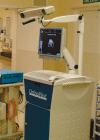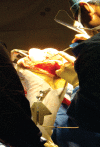Computer Assisted Total Knee Arthroplasty: Does it Make a Difference?
- PMID: 24371482
- PMCID: PMC3865127
Computer Assisted Total Knee Arthroplasty: Does it Make a Difference?
Abstract
The longevity of total knee prostheses depends mostly on the correct alignment (frontal, sagittal and axial) of the prosthetic components, soft tissue balancing and restoring the mechanical axis of the lower limb.The use of computer-assisted navigation allows more accurate and reproducible restoration of mechanical axis and component positioning, better results in patients with extra-articular deformities and it has an important role in surgical training.Better alignment should lead to an improved functional outcome and an increased long-term survival of the prosthesis. Several studies have proven an improved function in the short and mid-term but we still lack long-term data regarding functional outcome and longevity of the prostheses.
Keywords: computer-assisted; navigation; total knee arthroplasty.
Figures





References
-
- Dillon CF, Rasch EK, G U. Prevalence of knee osteoarthritis in the United States: arthritis data from the Third National Health and Nutrition Examination. J Rheumatol. 2006;33:2271–9. - PubMed
-
- Hofmann S, Djahani O, Pietsch M. Conventional Navigation without Computer and the Lateral Minimally Invasive Approach for Contract Valgus Knees. Orthopäde. 2007;3006:1135–1142. - PubMed
-
- Parratte S, Pagnano MW, Trousdale RT, et al. Effect of Postoperative Mechanical Axis Alignment on the Fifteen-Year Survival of Modern, Cemented Total Knee Replacements. JBJS Am. 2010;92:2143–2149. - PubMed
-
- Seitlinger G, Beitzel K, Scheureck G, et al. The Painful Patellofemoral Joint: Biomechanics, Diagnosis and Therapy. Orthopäde. 2011;40:353–370. - PubMed
Publication types
LinkOut - more resources
Full Text Sources
